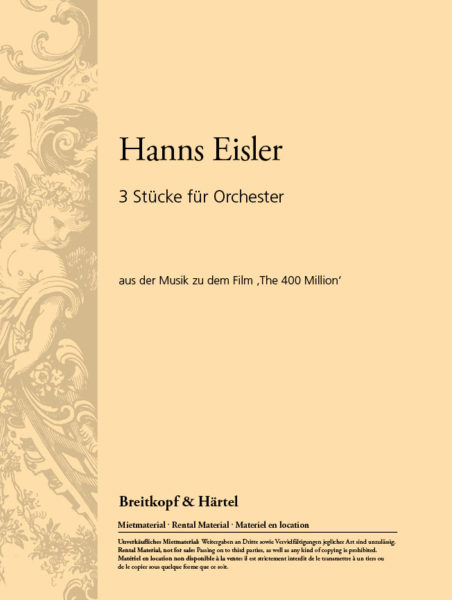Hanns Eisler (1898–1962) 3 Stücke für Orchester op. post.
aus der Musik zum Film „The 400 Million“ bearbeitet von Manfred Grabs [Orch] 1938/73 Dauer: 14'
1.1.1.1 – 1.1.1.0 – Schl – Str
Im April 1938 entstand in New York eine umfangreiche, rein zwölftönige Musik zu Ivens China-Dokumentarfilm „The 400 Million“, einer Darstellung des chinesischen Befreiungskampfes während der dreißiger Jahre. Aus dieser Filmmusik stellte der Komponist 1940 seine „Fünf Orchesterstücke“ zusammen, Musterbeispiele Eislerscher Behandlung der Zwölfton-Reihe, wo im Rahmen der musikalischen Bildbeziehung das Detail ja auch im Zwölftonsystem stimmen musste, ohne etwa mechanisch zu wirken. 1958 meinte er dazu im Gespräch: „Ich probiere seit zwei Tagen ein Werk, das ich vor ungefähr einundzwanzig Jahren geschrieben habe, das nun wirklich anstrebt, auf großer technischer Höhe zu sein. Und jetzt seh ich, mit was habe ichs erzielt? Dass nun dieser Schwung oder Kraft oder auch Brutalität, die in den Stücken vorkommen, auf dieser technischen Höhe sind, macht mich erst mit dem Stück zufrieden. Hätte ich es mit anderen Mitteln erreicht, würde ich sagen: Ist ganz effektvoll. Aber das ist mehr als das. Ich glaube, dass zum Beispiel dieses Werk und andere Werke von mir eben nicht nur Effekte anstreben, die da sind. Und wenn einem das gelingt, glaube ich, hat ein Komponist wirklich gearbeitet.“
Posthum stellte Manfred Grabs 1973 aus der überlieferten Filmpartitur zu „The 400 Million“ noch die „Drei Stücke für Orchester“ zusammen.
(Jürgen Schebera)
| 1. Andante con moto | (3'30) |
| 2. Molto allegro | (3') |
| 3. Thema mit Variationen (Der lange Marsch) | (7'30) |









